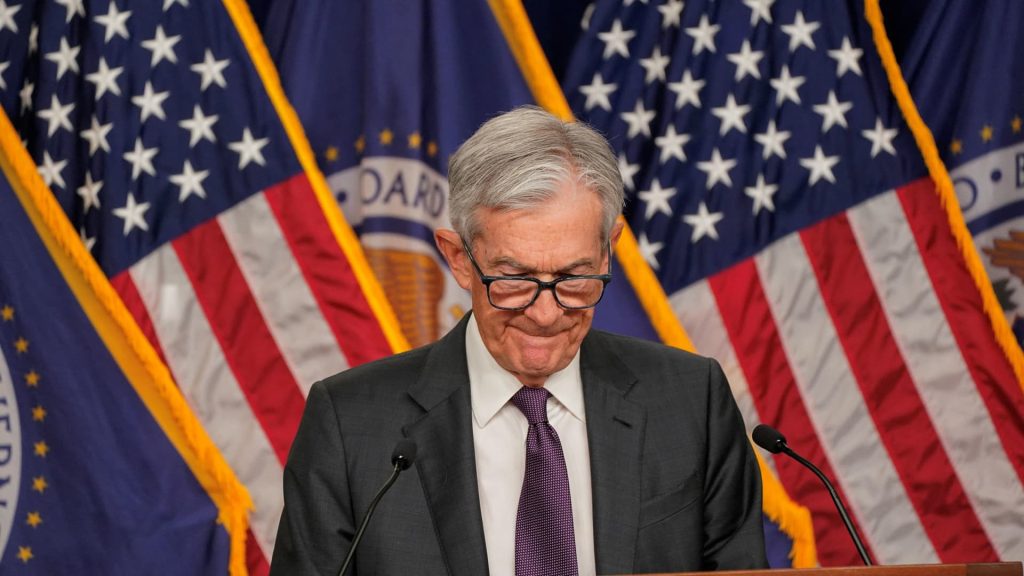
Amid a decidedly stagflationary forecast, including higher inflation and unemployment and surging odds of recession, respondents to the May CNBC Fed Survey still believe the Federal Reserve will cut interest rates this year and next.
Asked how the Fed will respond to not only persistently higher prices from tariffs but also weakening growth and employment, 65% of say the Fed will cut rates to address the economic weakness despite the inflation.
That’s up from 44% in the March survey when the majority thought the Fed would hold in that scenario. Only 26% say the Fed will hold rates when faced with the stagflation dilemma and just 3% believe the Fed will hike rates.
The 31 respondents, who include fund managers, analysts and economists, see the Fed funds rate declining to 3.71% by year end and 3.36% by the end of 2026 for a near 100-basis point decline over the period from the current level of 4.33%.
The odds of recession in the next year rose to 53%, up from 22% in January for the biggest two-survey increase since 2022. That’s when the Fed was just beginning its sharp rate hikes to battle inflation.
The consumer price index is seen ratcheting up from the current level of 2.4% to 3.2% by year end, but declining next year back to 2.6%.
At the same time, the unemployment rate is expected to rise from 4.2% to 4.7% and hold at about that level in 2026.
GDP is forecast at just 0.8% on average for this year, down from last year’s 3.1% growth rate.
Looking for growth
“The Fed must project an inflation fighting stance, but in most circumstances they will react more quickly to labor market weakness,” said Lou Brien, strategist with DRW Trading Group. “So, in the current circumstance, when the unemployment rate rises a few more tenths, and/or payrolls decline, the Fed will lower rates and suggest economic weakness will dampen inflation.”
But those cuts, said Richard Bernstein of Richard Bernstein Advisors, would mean the Fed “giving up on the 2% inflation target, perhaps permanently.” Fed officials have insisted they would not adjust the 2% target.
The average respondent sees growth rebounding to around 2% in 2026. Some say that’s because other, more positive parts of the Trump administration’s economic policies will kick in.
“By the second half of 2026, we expect that the tax and deregulation policies pursued by the administration will return the economy to a better trajectory of growth,” said Thomas Simons, chief U.S. economist at Jefferies.
Respondents do not believe stocks are currently priced correctly for the more downbeat outlook this year with 45% saying equities are not priced for a recession and 52% saying they are only somewhat correctly priced.
Overall, 69% believe the stock market is significantly or somewhat overpriced, up from 56% in the March survey. The average forecast sees the S&P finishing flat on the year relative to current levels but rising nearly 11% by the end of 2026.
“Although equity prices are undervalued, the level of stock market optimism remains too high. Most likely there are further declines ahead,” said Hugh Johnson of Hugh Johnson Economics.
Worries over tariffs
Some of the increased bearishness on the economy looks linked to the increasing belief that some form of a high tariff regime will be permanent.
A 63% majority of respondents to the CNBC Fed Survey believe across-the-board 10% tariffs will likely remain on all U.S. imports after the completion of new trade deals. Strong majorities see tariffs as a negative for the US growth, employment and inflation.
“Uncertainty surrounding tariff policy and objectives are weighing on planned investment and new orders,” said Constance Hunter, chief economist at the Economist Intelligence Unit.
Jack Kleinhenz, chief economist at the National Retail Federation adds, “Everyone is worried, not yet sure that anyone can predict the storm path of tariffs and their impact on the economy given so much uncertainty. Hopefully, price sensitive consumers can withstand the potential threatening nature of tariffs.”
Complicating the outlook: 74% of those who see tariffs as negative for the economy do not believe that promised deregulation and tax cuts from the administration will offset the negative impact of tariffs.
Drew Matus chief market strategist at MetLife Investment Management says, “Tariffs should have been sequenced post tax cuts so the negative shock was following a positive shock.”
Meanwhile, 73% say the combination of the administration’s tariff, immigration and foreign policies have damaged the U.S. brand in a way that is negative for the image of companies overseas and 83% say they are a negative for the attractiveness of U.S. assets.


